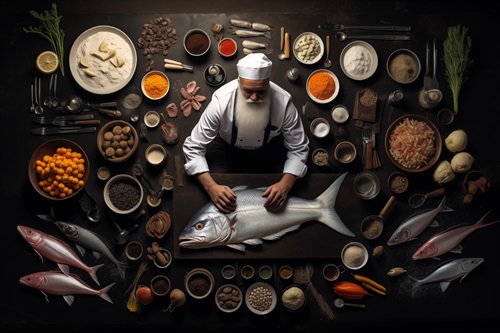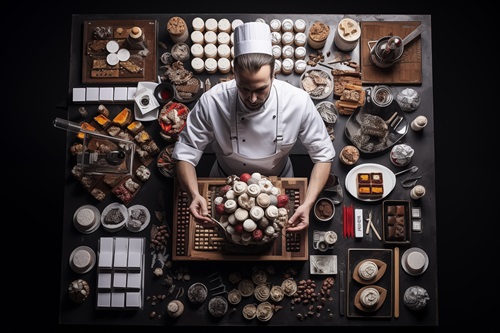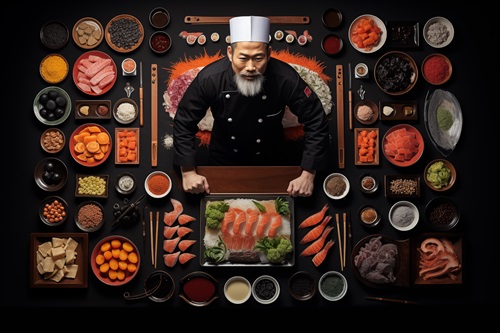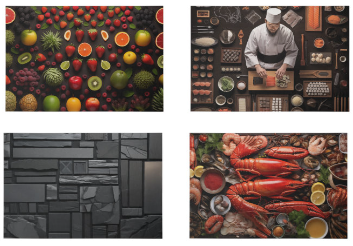
- Details
- Written by: Super User
- Category: Chef Knolling
- Hits: 360
In the heart of a bustling seafood kitchen, a fish chef stands as the epicenter of culinary creation, surrounded by a meticulously arranged array of ingredients and tools. This scene, reminiscent of the precise and orderly art of knolling, is more than a mere display of organization; it is a testament to the chef's dedication to his craft.
The Fish Chef: A Culinary Maestro
Dressed in a crisp white chef’s coat, the fish chef is a master of his domain, a virtuoso in the preparation of seafood. His role transcends the boundaries of traditional cooking, blending artistry with technical skill. He is not just a cook but a culinary artisan, deeply knowledgeable about various fish species, their textures, flavors, and the best methods of preparation.
The Art of Knolling: A Chef’s Organizational Mastery
The chef’s workspace is a canvas where the art of knolling is brought to life. This method involves arranging tools and ingredients at precise 90-degree angles, creating an organized and visually appealing workspace. This systematic arrangement allows the chef easy access to his tools and ingredients, facilitating efficiency and precision in his fast-paced environment.
Ingredients: The Building Blocks of Seafood Cuisine
Surrounding the chef is a diverse range of high-quality, fresh ingredients, each playing a crucial role in his culinary creations. There are slabs of fresh salmon, tuna, and halibut, their vibrant colors and textures speaking of the ocean’s bounty. Shellfish like lobsters, crabs, scallops, and mussels add variety to the selection, each requiring its unique preparation method.
Vegetables like lemons, herbs, and leafy greens are also part of the chef's palette, providing fresh, aromatic accents to the dishes. Essential seasonings such as sea salt, pepper, and specialty spices are within arm’s reach, ready to enhance the natural flavors of the seafood.
The Chef’s Role: An Expert in Seafood Preparation
The fish chef's responsibilities are multifaceted. He is an expert in selecting the freshest seafood, understanding the nuances that determine quality and flavor. His skill extends to expertly filleting fish, shucking shellfish, and marinating or seasoning seafood to perfection.
He is also adept in various cooking techniques, whether it's grilling, poaching, or pan-searing, each method carefully chosen to complement the specific type of seafood. The chef’s expertise ensures that every dish maintains the delicate balance of flavors and textures inherent in high-quality seafood.
Conclusion: A Symphony of Seafood Flavors
As the chef works, there's a sense of rhythm and flow in his movements, a harmony born of years of experience. The knolling around him is not just a testament to his organizational skills but also a reflection of his methodical approach to cooking. Each dish that leaves his kitchen is a celebration of the sea, an amalgamation of fresh ingredients, skillful preparation, and artistic presentation.
In this space, the fish chef continues to weave his culinary magic, crafting dishes that are not only a delight for the palate but also a feast for the eyes, maintaining the legacy of seafood cuisine with each meticulously prepared creation.

- Details
- Written by: Super User
- Category: Chef Knolling
- Hits: 269
In a sunlit, fragrant bakery kitchen, a pastry chef stands surrounded by an artfully arranged collection of ingredients and tools, a scene that brings to mind the meticulous art of knolling. This chef, a maestro of dough and sugar, is more than just a baker; he is an alchemist transforming basic elements into edible masterpieces. The tableau around him, organized with geometric precision, is not just for aesthetic value; it's a reflection of the precision and passion that drives his culinary creations.
The Pastry Chef: An Artist and Scientist in the Culinary World
The pastry chef, dressed in a crisp white coat and a flour-dusted apron, represents a unique blend of artist and scientist. His role is multifaceted: he is a creator of delicate pastries, a designer of intricate desserts, and a technician adept in the chemistry of baking. The art of pastry making demands not only creativity and flair but also an exacting adherence to technique and detail.
The Principle of Knolling: Organizational Art in the Pastry Kitchen
The chef's workspace is a canvas where the principle of knolling—a method of arranging related items in parallel or 90-degree angles—is beautifully manifested. This layout enhances both efficiency and precision in the baking process. Each ingredient and tool is placed deliberately, allowing for seamless transitions between different stages of pastry preparation.
Ingredients: The Palette of the Pastry Chef
Encircling the chef is a variety of high-quality ingredients, essential to the art of pastry making. Bags of fine flour, granulated and powdered sugars, jars of artisanal honey, and blocks of butter form the foundation. Nearby, fresh fruits, including berries, citrus, and apples, await their transformation into fillings and garnishes.
Eggs, a staple in the pastry kitchen, are strategically placed. Various nuts, chocolate chunks, and an array of spices like cinnamon, nutmeg, and vanilla pods add complexity and depth to his creations. Containers of cream, milk, and artisanal cheeses like mascarpone and ricotta speak to the rich textures and flavors he expertly infuses into his pastries.
The Chef's Role: Beyond Baking
The pastry chef's role goes beyond simply mixing and baking. It involves an intimate understanding of how different ingredients interact under varying conditions. He knows precisely how temperature, humidity, and proportions impact the texture and flavor of his creations.
His expertise extends to skillfully manipulating dough, crafting airy pastries, and creating luscious creams and custards. The chef is also a master decorator, adept at using icing, fondant, and chocolate to turn desserts into visual feasts.
In Conclusion: A Symphony of Sweets and Creativity
As the pastry chef works, there's a rhythm to his movements, an elegant dance of creation. The knolled layout of his ingredients and tools is a testament to his commitment to organization and precision. Each pastry, pie, or cake that emerges from his oven is not just a treat for the taste buds but a celebration of the art of pastry making.
In this space, the pastry chef continues to enchant and delight, one exquisite dessert at a time, upholding the traditions of his craft while infusing it with his unique creative vision.

- Details
- Written by: Super User
- Category: Chef Knolling
- Hits: 275
In the center of a meticulously organized kitchen, a sushi chef stands as a beacon of culinary tradition and expertise. This chef, skilled in the ancient art of sushi making, is surrounded by an array of raw ingredients, each carefully placed in a precise, organized manner that echoes the principles of knolling. This setup not only highlights the aesthetic beauty of the ingredients but also reflects the chef's deep respect for order and discipline in his craft.
The Sushi Chef: A Master of Balance and Precision
Dressed in a traditional kimono and hachimaki, the sushi chef represents a blend of artist, craftsman, and culinary expert. His role is steeped in tradition, requiring years of dedicated training to master the intricate skills of sushi preparation. He is not just a cook; he is the guardian of a culinary art form that balances taste, texture, and presentation in perfect harmony.
Knolling: An Art of Organization in Sushi Cuisine
The chef's workspace is a testament to the practice of knolling - arranging items at 90-degree angles to create an organized environment. This methodical layout serves a dual purpose: it enhances the visual appeal of the ingredients and allows the chef to efficiently access everything he needs. The discipline of knolling mirrors the precision required in sushi preparation, where every detail matters.
The Ingredients: A Palette of Freshness and Quality
Surrounding the chef is a cornucopia of the finest ingredients, each chosen for its freshness and quality. Slabs of sashimi-grade fish like tuna, salmon, and eel, each with their distinct color and texture, are prominently displayed. Beside them are shelled shrimp, creamy scallops, and bright orange roe, adding to the spectrum of seafood varieties.
Vegetables and accompaniments are also part of the knolling arrangement. Crisp cucumbers, ripe avocados, and tangy pickled radishes are ready to be sliced and incorporated into the sushi. Wasabi, soy sauce, and pickled ginger are strategically placed for seasoning and garnishing, essential for the complete sushi experience.
The Chef's Role: Beyond Preparing Sushi
The chef's responsibilities extend beyond merely assembling sushi. His expertise involves understanding the unique characteristics of each ingredient. He knows precisely how to slice fish to maximize flavor and texture, and how to season and mold the sushi rice to achieve the perfect balance.
Presentation is key in sushi making, and the chef is a master of this art. He arranges each piece of sushi on the plate with an eye for aesthetics, ensuring that the final presentation is as pleasing to the eye as it is to the palate.
In Conclusion: A Symphony of Flavors and Artistry
As the chef works, there is an air of tranquility and focus that surrounds him. The knolled arrangement of his ingredients not only facilitates efficiency but also symbolizes his respect for the ingredients and the sushi-making process. Each piece of sushi he crafts is a small work of art, reflecting a balance of tradition, flavor, and meticulous attention to detail. In this space, the sushi chef continues to honor and perpetuate the revered art of sushi, one meticulously crafted piece at a time.
